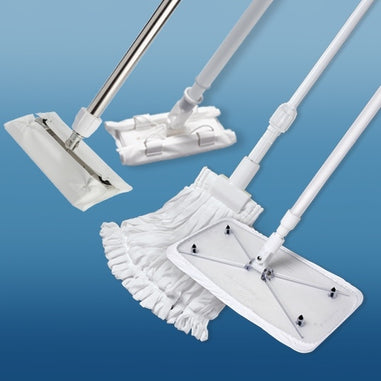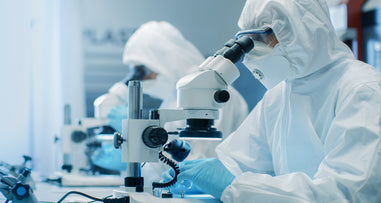- No products in the cart.
Cleanrooms are vital environments in various industries, from pharmaceuticals to electronics manufacturing, where the utmost cleanliness and contamination control are critical. In such environments, cleanroom gloves play a pivotal role in safeguarding both the products being manufactured and the personnel handling them. Selecting the appropriate gloves for your cleanroom is a crucial decision. In this comprehensive guide, we will explore the key factors to consider when choosing cleanroom gloves, ensuring that you make an informed decision that aligns with your specific cleanroom requirements.
Understanding Cleanroom Classifications
Cleanrooms are classified according to their levels of cleanliness, typically measured in terms of the number and size of particles allowed per cubic meter of air. These classifications are defined by organizations such as the International Organization for Standardization (ISO) and the United States Federal Standard 209E. It's important to know your cleanroom's classification as it directly impacts the type of gloves you should choose.
Material Matters
Cleanroom gloves come in various materials, each offering unique advantages and disadvantages. The most common materials include:
-
Latex Gloves: Latex gloves are known for their excellent dexterity and tactile sensitivity. However, they may not be suitable for individuals with latex allergies, and latex-free alternatives are often preferred.
-
Nitrile Gloves: Nitrile gloves are a popular choice due to their resistance to chemicals, punctures, and abrasion. They are a good option for those with latex allergies.
-
Vinyl Gloves: Vinyl gloves are cost-effective and provide adequate protection in less critical cleanroom environments. However, they are less durable and may not be suitable for all applications.
-
Neoprene Gloves: Neoprene gloves offer superior chemical resistance and are commonly used in pharmaceutical and biotech cleanrooms.
-
Butyl Rubber Gloves: These gloves provide exceptional resistance to a wide range of chemicals and are often used in highly hazardous cleanroom settings.
-
Sterile Gloves: When working in aseptic cleanrooms or environments with strict contamination control requirements, sterile gloves are essential to prevent the introduction of microorganisms.

Glove Thickness and Length
The thickness and length of cleanroom gloves can vary significantly. Thicker gloves provide greater durability and protection against chemical exposure, while thinner gloves offer improved dexterity and tactile sensitivity. The choice between short (wrist-length) and long (elbow-length or beyond) gloves depends on the level of protection required in your cleanroom environment.
Glove Sterility
Sterility is a critical factor in cleanroom operations, especially in pharmaceutical and biotech industries. Sterile gloves are typically individually packaged and irradiated to eliminate any potential microbial contamination. Ensure that the gloves you choose meet the sterility requirements of your cleanroom.
Size and Fit
Proper sizing and fit are essential to ensure comfort and prevent hand fatigue during prolonged glove use. Ill-fitting gloves can compromise dexterity and tactile sensitivity. Be sure to measure and select the correct glove size for each member of your cleanroom team.
Glove Compatibility with Chemicals
Consider the chemicals and substances your cleanroom personnel will be handling. Some glove materials may not be compatible with certain chemicals, leading to degradation or permeation. Ensure that the gloves you choose are suitable for the chemicals present in your cleanroom.
Cleanroom Glove Testing and Certification
Reputable cleanroom glove manufacturers subject their products to rigorous testing to ensure they meet industry standards for cleanliness and performance. Look for gloves that are tested and certified according to relevant standards, such as those set by ISO or ASTM International.
Choosing Between Sterile and Non-Sterile Gloves
In cleanrooms where sterility is paramount, such as in pharmaceutical manufacturing or biotech research, sterile gloves are a must. These gloves undergo aseptic processing and are individually packaged to prevent contamination before use.
Non-sterile gloves, on the other hand, are suitable for cleanrooms with less stringent requirements, such as electronics manufacturing or semiconductor fabrication. These gloves are typically packaged in bulk and are designed to protect products and processes from contamination but not necessarily to maintain sterility.
Double Gloving
In some cleanroom applications, double gloving is recommended to enhance protection. This involves wearing two pairs of gloves – a primary pair and a secondary pair. Double gloving can provide an extra layer of protection in case the primary gloves are compromised.
Cleanroom Glove Storage and Handling
Proper storage and handling of cleanroom gloves are crucial to maintaining their integrity. Store gloves in a clean and dry environment, away from direct sunlight and sources of heat or moisture. Avoid touching the interior of the gloves with bare hands. When donning gloves, do so carefully to minimize the risk of contamination.
Regular Changeout
Cleanroom gloves should be changed regularly to prevent the accumulation of contaminants and to maintain their effectiveness. The frequency of glove changeout will depend on the specific cleanroom classification and the nature of the work being performed.
In addition to the factors mentioned above, there are a few other things to keep in mind when choosing cleanroom gloves:
- Electrostatic discharge (ESD) protection: Some cleanroom environments are sensitive to static electricity. In these cases, you will need to choose gloves that are ESD-resistant.
- Chemical compatibility: The gloves you choose must be compatible with the chemicals that will be used in the cleanroom environment.
- Temperature resistance: The gloves you choose must be able to withstand the temperature range of the cleanroom environment.
Conclusion
Choosing the right cleanroom gloves is a decision that should not be taken lightly. The gloves you select have a direct impact on the cleanliness and safety of your cleanroom environment and the quality of your products. By considering factors such as material, thickness, length, sterility, compatibility with chemicals, size and fit, and adherence to industry standards, you can make an informed choice that aligns with your cleanroom requirements. Remember that proper storage, handling, and changeout practices are equally important to ensure the continued effectiveness of your cleanroom gloves. When it comes to safeguarding your cleanroom operations, investing time and attention in glove selection is a wise investment.
For over 40 years, Lab Pro Inc. is your steadfast source for premium cleanroom lab supplies, hand tools, lab equipment, chemicals, and PPE apparel. Trusted by aerospace industries, medical device companies, and laboratories globally, we epitomize exceptional quality in every product. Experience the convenience of next day service in California. Contact us online or at 888-452-2776 to explore solutions tailor-made for the laboratory industry. Elevate your experiments with Lab Pro Inc. – your partner in precision and excellence.












































